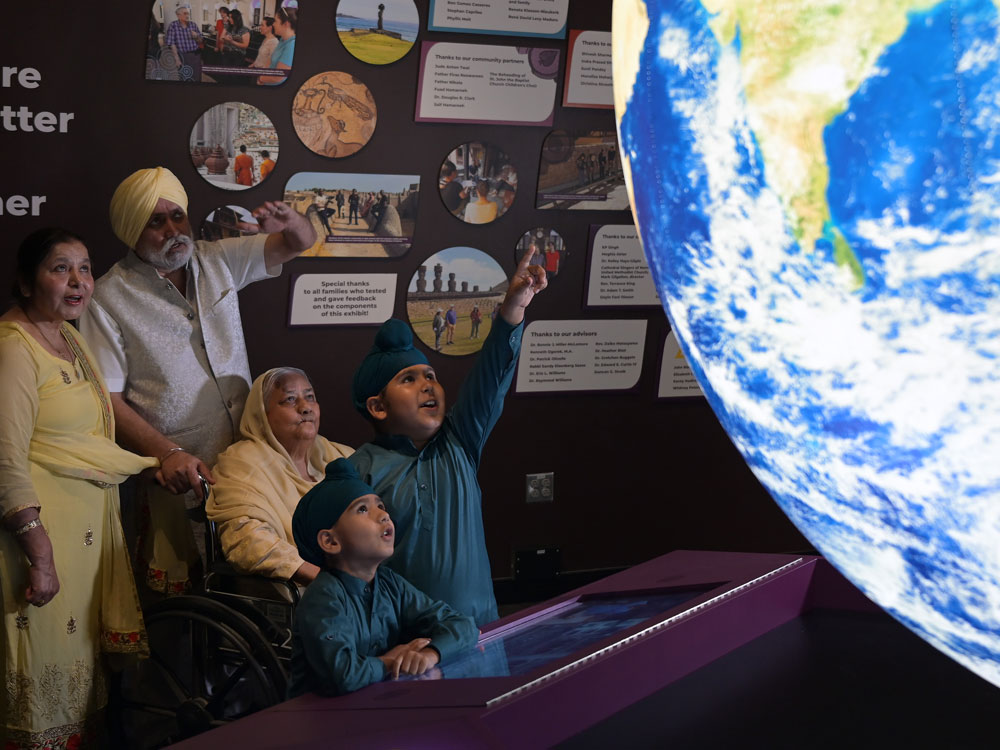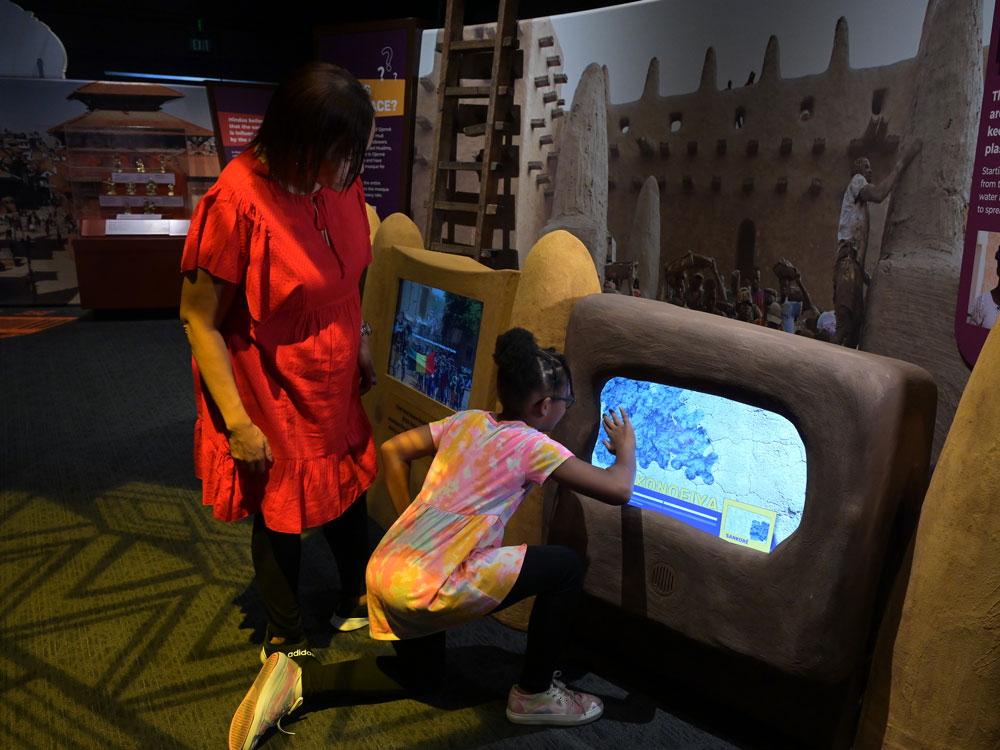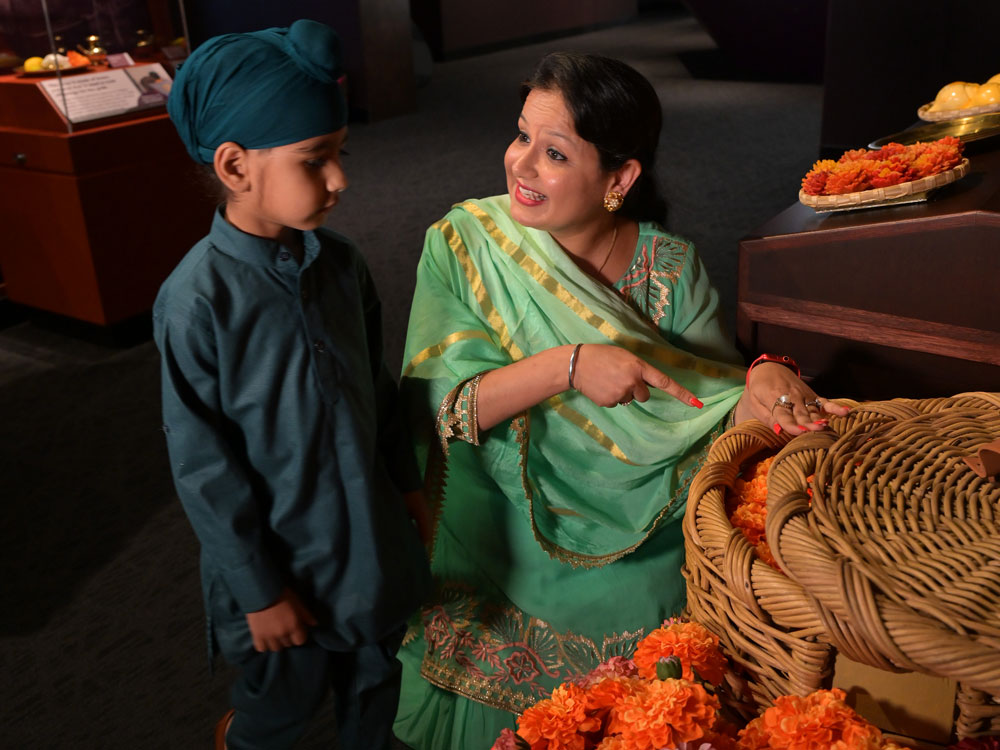We take pride at The Children’s Museum in educating families on topics that shape our perspective and views about the world and communities in which we live. Many of our exhibits and experiences provide families with the opportunity to have discussions surrounding diversity and inclusion which can help families learn about places, people, traditions, or even moments in history.
Our newest exhibit, Sacred Places, opened on Sept. 7. It will encourage families to learn together about sacred places across the world by listening to community members' stories and looking at sacred objects that tell us about traditions and customs celebrated all over the world. This can lay a foundation that can help us better communicate with our neighbors around the world, leading to mutual understanding and respect for cultural, religious, and spirituality differences.

As a parent, we realize that this could be a challenging conversation. These topics and conversations aren’t often themes that adults and caregivers think are fitting for young children. However, we firmly believe it is important to have these conversations with young children in developmentally appropriate ways. And we’re here to help!
We partnered with Elyse Handel, Early Childhood Education Manager at The Children’s Museum, to create a series of posts that will support you—families and caregivers with young children—as you prepare to visit this exhibit together. We’ll share helpful information on the importance of having discussions about sacred places, religions, and customs practiced around the world that may differ from our own.
What can you expect from this blog series? What topics will be covered?
Over the next few weeks, we will continue to publish blog posts that can guide and support your visit to Sacred Places. Our focus in this post is to inform you about the exhibit, what to expect while visiting the exhibit, and how you can prepare for your visit.
Here is what you can look forward to in future blog posts:
- Suggestions of interactives and experience to visit inside the exhibit with young children
- Suggestions on ways to lead a conversation with your young children about differing cultures and traditions
- Suggestions on ways adults can encourage young children to connect, relate, and understand content in the exhibit
- Reading list that include a list of books that your family can read together to continue conversations about diversity and inclusion
- Ways your family can take action and continue to learn together about other religions, customs, and traditions other than your own
What does the Sacred Places exhibit feature and include? What stories are told?
Sacred Places is an immersive exhibit that welcomes families to explore and learn about sacred places in different parts of the world. The exhibit will also showcase sacred traditions as well as feature a variety of unique and personal objects to help tell the stories of the important customs and traditions that may occur in the sacred place. It highlights the diversity of religions and spirituality that’re practiced not only by community members here in Indianapolis, but around the world.
In addition to the stories that are told through objects, six immersive areas welcome you to explore different places through the eyes of a young guide. These guides describe how they feel, what they do, and what they experience when they visit their sacred site.
Sacred Places also includes interactive activities where your family can engage and interact with stories from around the world. It will also feature programming led by our museum staff. Playing the role of photojournalist, they are stationed inside the exhibit to help guide your family experiences. You are more than welcome to ask them for suggestions on where to explore inside the exhibit.

Here are a list of the six immersive areas and the sacred sites they represent:
Mikvé Israel-Emanuel Synagogue
Willemstad, Curaçao
Explore the oldest “living” synagogue in the Americas. Meet Nathan—a member of the community who leads morning prayer services. Learn about the importance of community in the Jewish faith.
Beheading of St. John the Baptist Church & St. George Church
Madaba, Jordan
Explore Christian sites in the heart of biblical holy lands. Meet Jude—a member of the community who leads the congregation in prayer during mass and hear about the ancient church tradition of telling biblical stories through intricate mosaics.
Great Mosque of Djenné
Djenné, Republic of Mali
Explore one of Africa’s most famous buildings and the largest mud and brick structure on Earth. Meet Aïssata—a member of the community who organizes the girls in her neighborhood for replastering of the structure, an annual, festive community event.
Patan Durbar Square
Lalitpur, Nepal
Explore the bustling square filled with a beautiful palace and 55 major Hindu temples, each one dedicated to a god. Meet Shivesh—a member of the community who performs daily puja offerings at the Keshav Narayan Temple.
Rapa Nui
Rapa Nui, Chile
Explore Rapa Nui—also known as Easter Island. Meet Merahi—a member of the community who honors the moai, ancestors embodied by ancient and enormous stone statues.
Wat Arun
Bangkok, Thailand
Explore one of the most remarkable Buddhist temples in Thailand. Meet Kaew—a member of the community who is a monk-in-training and follow him on his daily routine, including morning and evening chants in the prayer space and collection of food offerings throughout the community.
Sacred Places also features a projection or immersive theater that transports you to the middle of sacred places around the world—and right here in Indianapolis, too. You’ll be surrounded by the sights and sounds of these beautiful spaces.
Q. Is Sacred Places an exhibit that I should take my young children to? What if we are not religious?
While the exhibit does highlight spirituality and religions connected to sacred places around the world, the exhibit’s focus itself is not about religion. You do not need to have prior understanding or connections to any religion in order to visit this exhibit. We encourage your family to visit the Sacred Places exhibit to learn about communities and sacred places which can support your understanding about communities, cultures, and traditions around the world.

Young children are just beginning to make sense of their world and it’s critical to point out and discuss differences to help them develop a respectful and inclusive view of people and places around the world. Having discussions with your children in Sacred Places will support your child’s understanding about the world, and simply what makes us similar and different from one another. The exhibit will expose them to beautiful and culturally diverse people and places around the world.
A future blog post will go into more depth about how you can engage your child in conversations surrounding diversity.
Q. Are there ways I can prepare my family and children prior to visiting the museum?
It will be easier for young children to make connections to other cultures, traditions, and sacred places when they have a foundational understanding of what is important to them and their own family. You can do this by discussing places you travel to as a family! Where is somewhere your family goes that is special? It doesn’t have to be far away! It could be the park, a grandparent’s house, church, or even a restaurant in town. Discuss what you do when you go there and why those experiences and traditions are important to your family. How do they make you feel?
You can also show your child the Sacred Places page on our website.Young children sometimes need to know what to expect when engaging in new experiences, so providing them opportunities to become familiar with the exhibit before going can help them feel prepared and ready. Look at the pictures that are associated with each sacred site and read aloud the site guides’ stories about the sacred place and what they do there.
We’re here for you
We know that discussing religion, faith, and spirituality can be daunting for many parents. Many people wind up avoiding those conversations altogether. We hope this series provides you the tools to begin having potentially challenging conversations with your young children about faith, religion, and seeking to understand other faiths in developmentally-appropriate ways. This will help them create a kinder, gentler, more compassionate world.
And the world could use more of that.
Sacred Places was made possible by Lilly Endowment, Inc.
Lilly Endowment Inc. is a private philanthropic foundation created in 1937 by J.K. Lilly Sr. and his sons Eli and J.K. Jr. through gifts of stock in their pharmaceutical business, Eli Lilly and Company. While those gifts remain the financial bedrock of the Endowment, it is a separate entity from the company, with a distinct governing board, staff and location. In keeping with the founders’ wishes, the Endowment supports the causes of community development, education and religion and maintains a special commitment to its hometown, Indianapolis, and home state, Indiana. The principal aim of the Endowment’s religion grantmaking is to deepen and enrich the lives of Christians in the United States, primarily by seeking out and supporting efforts that enhance the vitality of congregations and strengthen the pastoral and lay leadership of Christian communities. The Endowment also seeks to improve public understanding of diverse religious traditions by supporting fair and accurate portrayals of the role religion plays in the United States and across the globe.

 (
(











